Our Perth solar story (2020-now)
I love data, collect all sorts of household information and have an unhealthy enthusiasm for Excel. It started out of necessity in 2006 when we were a skint young family trying to pay a mortgage, juggle work and raise a family. It's become part-hobby, but still useful for decision-making. I have collated data on our energy use and energy bills leading up to, during, and after various stages of our solar and decarbonisation journey. Many find it useful or are curious so I made this page.
TL;DR over 2 years we got panels, a heat pump, a battery and an EV (well, two if you count son1's). As of now we make about 90% of our own energy and are charging two EVs mostly on solar surplus. We are saving over $6,500 a year in energy bills (more if you include son1 not paying for fossil fuel either). We use no fossil gas and barely any fossil fuels, the 2-monthly electricity bills got as low as $25, but the last 2 years with EVs are about $65 in summer and $150 in winter.
We went solar in 2020 during the COVID-19 pandemic. I knew nothing about solar at the time. This video on YouTube from the Solar 101 webpage is 25 mins and it explains everything. After watching it, I used Solar Quotes website to arrange 3 quotes and the guide at Solar 101 to work out what was good quality (there are charts for panels, inverter and racking).
In November 2020 for $7,500 we installed 6.65 kW (19) of panels, a 5 kW inverter and swapped our gas hot water system for an iStore 270L heat pump (works like an inside-out fridge with heat being dissipated into the water and the air around it gets cooled). The heat pump makes hot water from solar electricity during the day so it acts like a solar battery, see the specs of the iStore270L at the iStore site.
Thanks to the iStore our gas bill immediately plummeted to 10% what it was, but with solar (no battery) our electricity bill did not change as much as we hoped because (i) 12+ hours of overnight baseload is unavoidable, (ii) our spike of evening use after getting home from work is after solar stops generating (also some tariffs charge extra high 3-9pm), (iii) there’s a fixed ~$1 per day access charge, and (iv) we get paid a pathetic sum for what you export to the grid most of the day (2.5c/kWh ... it’s the lowest in all Australia).
This is why a year later in November 2021 for ~$10K we got a 10 kWh battery and 7 more solar panels (total 9.1 kW). The battery runs everything all evening and overnight (unless air con is running on a super hot night). Our bills got down to the price of a couple pints of beer, see Tweets from 29 April 2022 and 26 October 2022.
I went solar not just to save money, but to make less carbon dioxide myself as well as, in a tiny way, help hasten the decline of wasteful, polluting (and increasingly expensive) fossil fuels. During a long-awaited kitchen renovation in mid-2022 we ripped out the gas in the kitchen and went induction electric so gas got disconnected. The old BBQ out back we’ll have to use a gas bottle until we can find an electric BBQ.
In September 2022 we received our EV, an Atto-3 by BYD ... it replaced our 2011 diesel Captiva that’s now over 230,000 km. The charger we got was a Smappee EV Wall which was about $3K all up installed and it’s smart as it monitors the solar and can moderate its charging to put only surplus solar in the car. Son1 got an EV in October 2024 and started charging it at home as well. EVs comes with a ‘granny’ charger that plugs into the wall and is a slow ‘trickle’ charge. For the 3 types see EV charging 101.
In the charts below you can see what happened to our bills. The solar reduced our electricity bills by about $950 p.a. and the battery a further $1,100 p.a. The heat pump running off solar saved us $750 p.a. and going to electric induction for cooking in the kitchen and cutting off the gas saved another $150 p.a. I have included a diesel & petrol chart because that’s a huge household cost that your solar system can also negate if you can power your car(s) on solar surplus. For us fuel was $2.5K p.a. and rising with the boys driving and fuel costs to $4K a year. If you can power your EV on sunshine you will pay back your solar system (and even your car) really fast.
Energy Bills and Energy Usage
Here are charts of energy bills and usage from about the beginning of 2015. To the right where it says "zoom full image" you can click the link to view the full-size image in a new tab. The charts have trend lines.
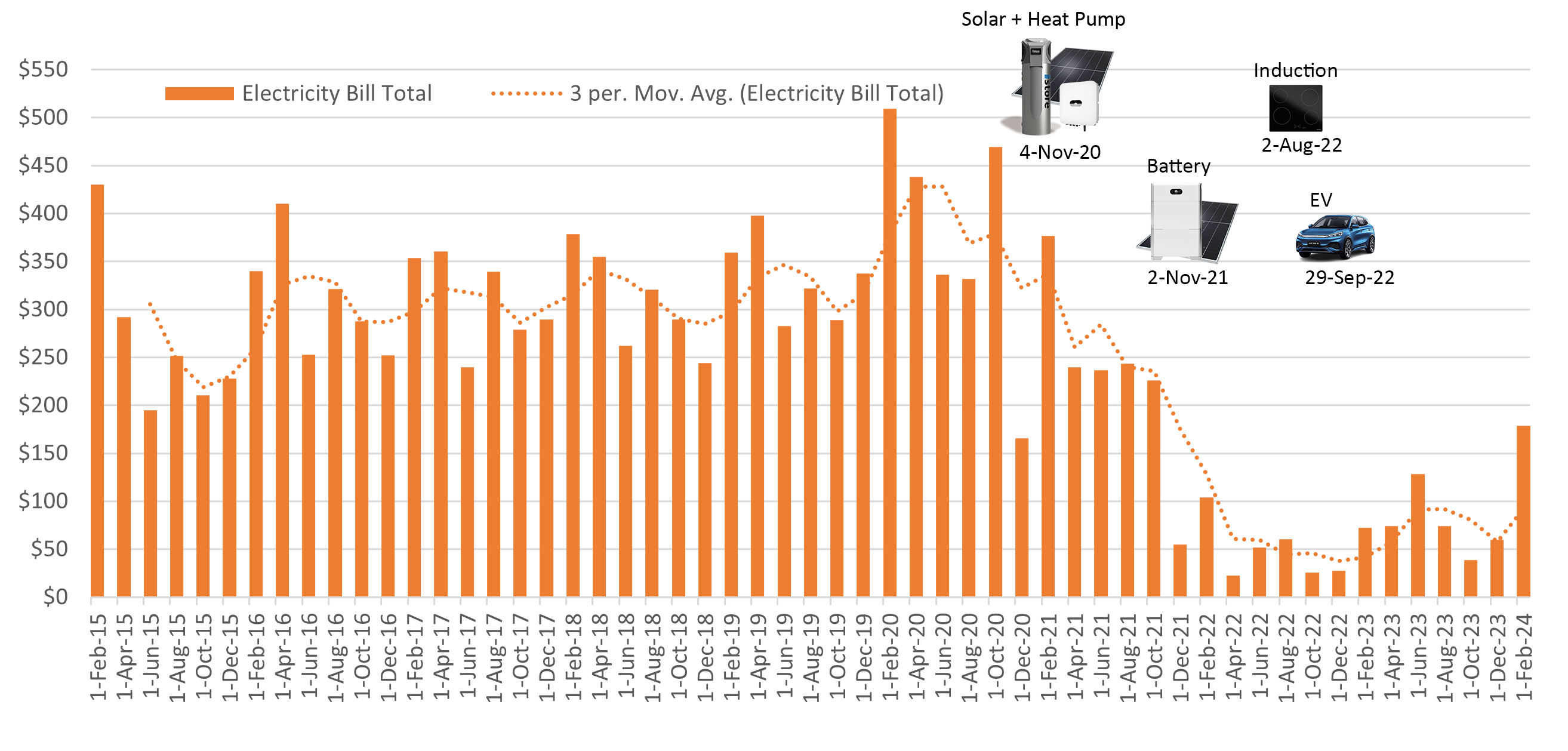
Electricity Bills (2015-now)
- Last updated: 1 January 2026 (zoom full image)
- In November 2020 we installed 6.65 kW of panels and a 5 kW inverter. The bills dropped by about $950 p.a., but not as much as we thought. This was for several reasons: (i) overnight baseload is unavoidable, (ii) there's a $1/day supply charge, (iii) during peak evening use we're paying 30c/kWh or 50c/kWh on other tariffs, (iv) we're paid poorly for exports to the grid (2.5c/kWh peak, 10c/kWh after 3pm). This is why in November 2021 we got a battery which saw the bills drop by a further $1,100 p.a. The record-breakingly hot 2024 February saw a bill uptick.
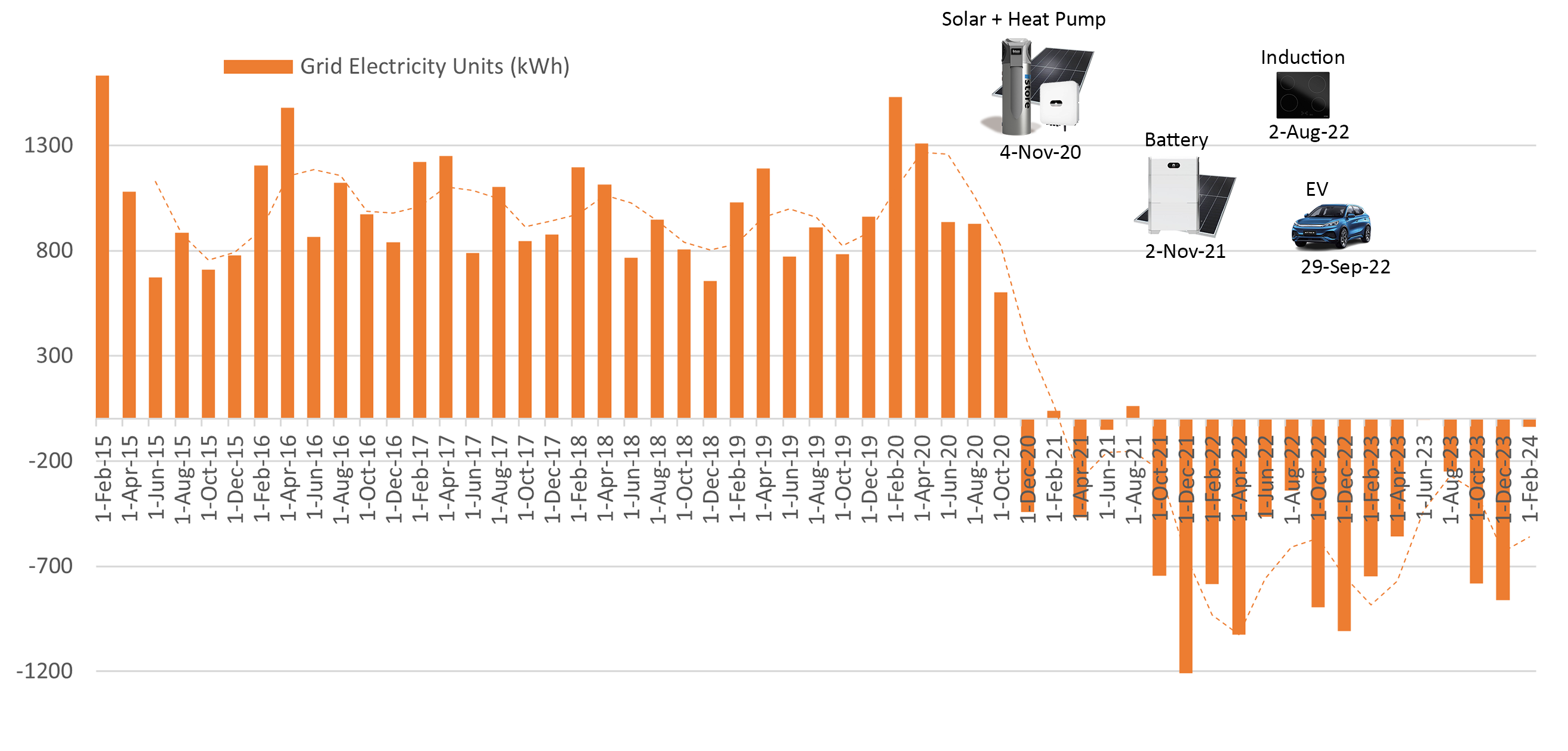
Electricity Usage (2015-now)
- Last updated: 1 January 2026 (zoom full image)
- This chart is less interesting. It shows net energy which is imports minus exports. It does not count energy used directly from the roof, or later from the battery. Unsurprisingly, after solar panels we were net exporters of electricity. In peak summer and winter it was almost even. The battery in November 2021 dramatically reduced imports, so with the same export net electricity is strongly exporting. The ~800 kWh exported many recent periods is what our household used pre-solar.
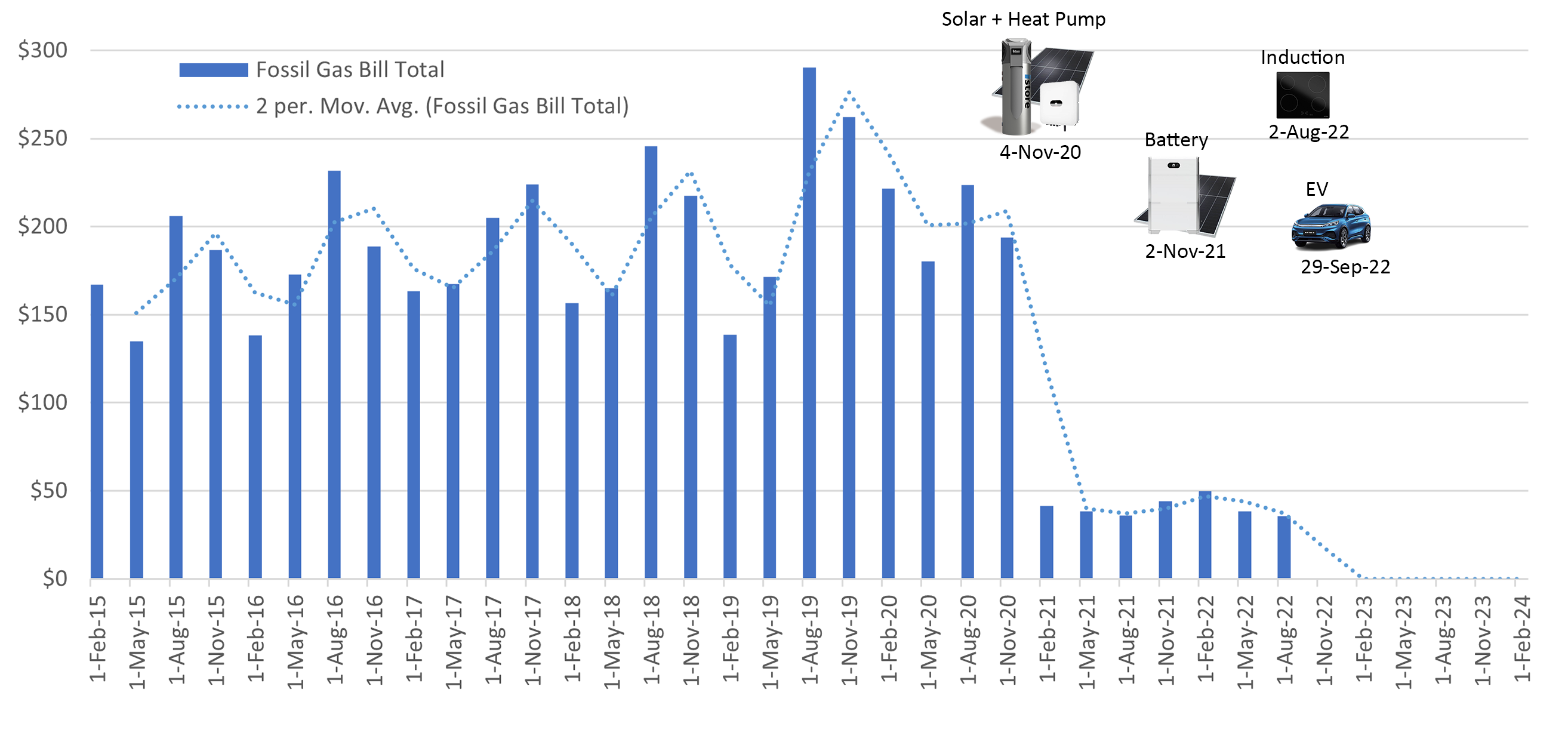
Gas Bills (2015-now)
- Last updated: 1 January 2026 (zoom full image)
- Getting the heat pump in November 2020 crushed the gas bill, dropping it 80% such that the bill was only gas used for cooking as well as the supply charge. So the iStore running off solar 'for free' saved us $750 p.a. In July 2022, a long-awaited kitchen renovation was the chance to disconnect the gas and go to an electric induction cooktop. Disconnecting gas meant no gas bill, saving a further $150 p.a. So all up, getting rid of gas in 2 steps eventually saved us $900 p.a. total.
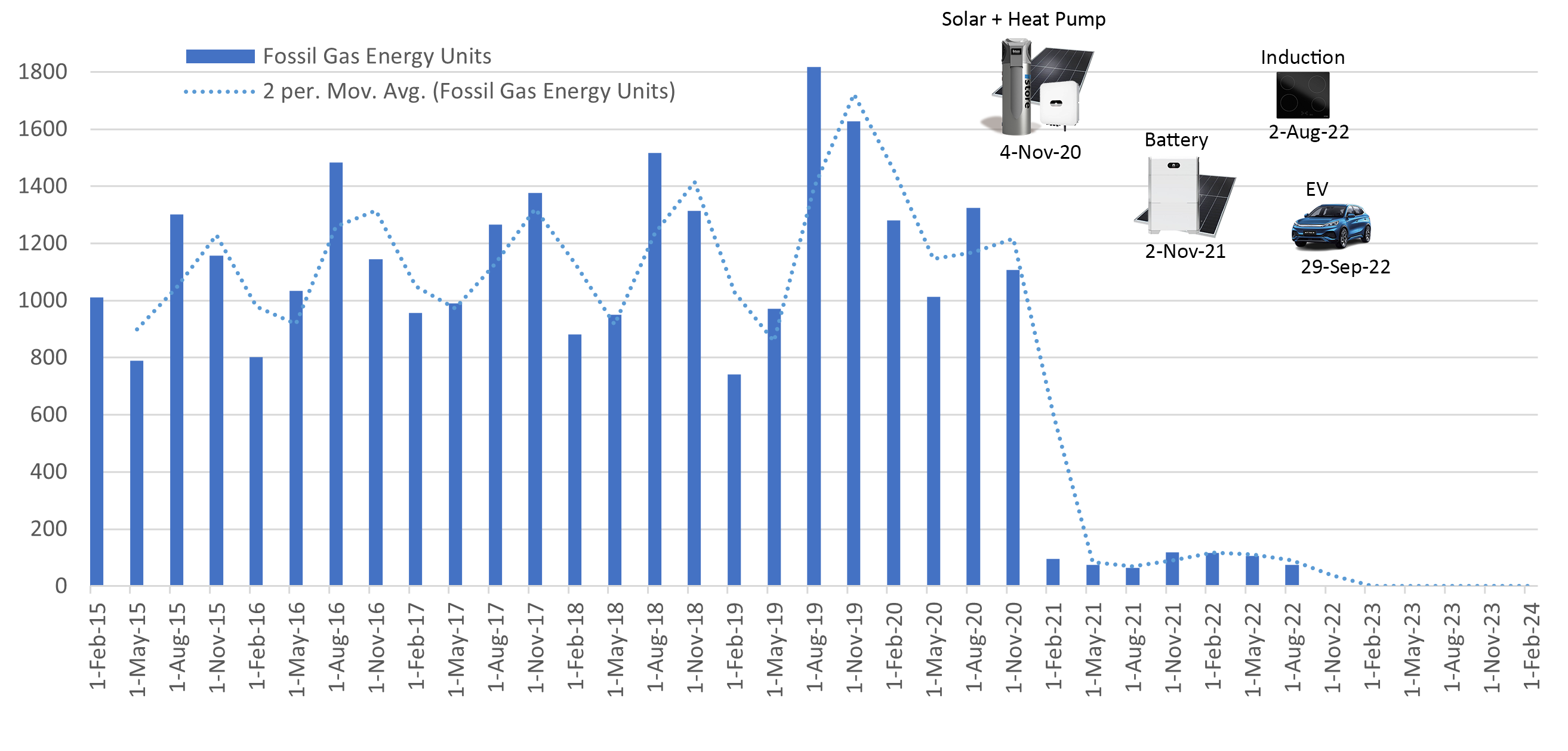
Gas Usage (2015-now)
- Last updated: 1 January 2026 (zoom full image)
- Use of gas for hot water peaks in colder months. After installation of the iStore 270L heat pump hot water storage system absolutely crushed gas usage by 95%. The only gas use after we went to the heat pump for hot water was the gas used for cooking in the kitchen and the BBQ out back. In mid-2022, a kitchen renovation was a chance to change gas cooking in the kitchen to an electric induction cooktop. The gas BBQ out back we have been unable to go electric, so it uses a bottle.
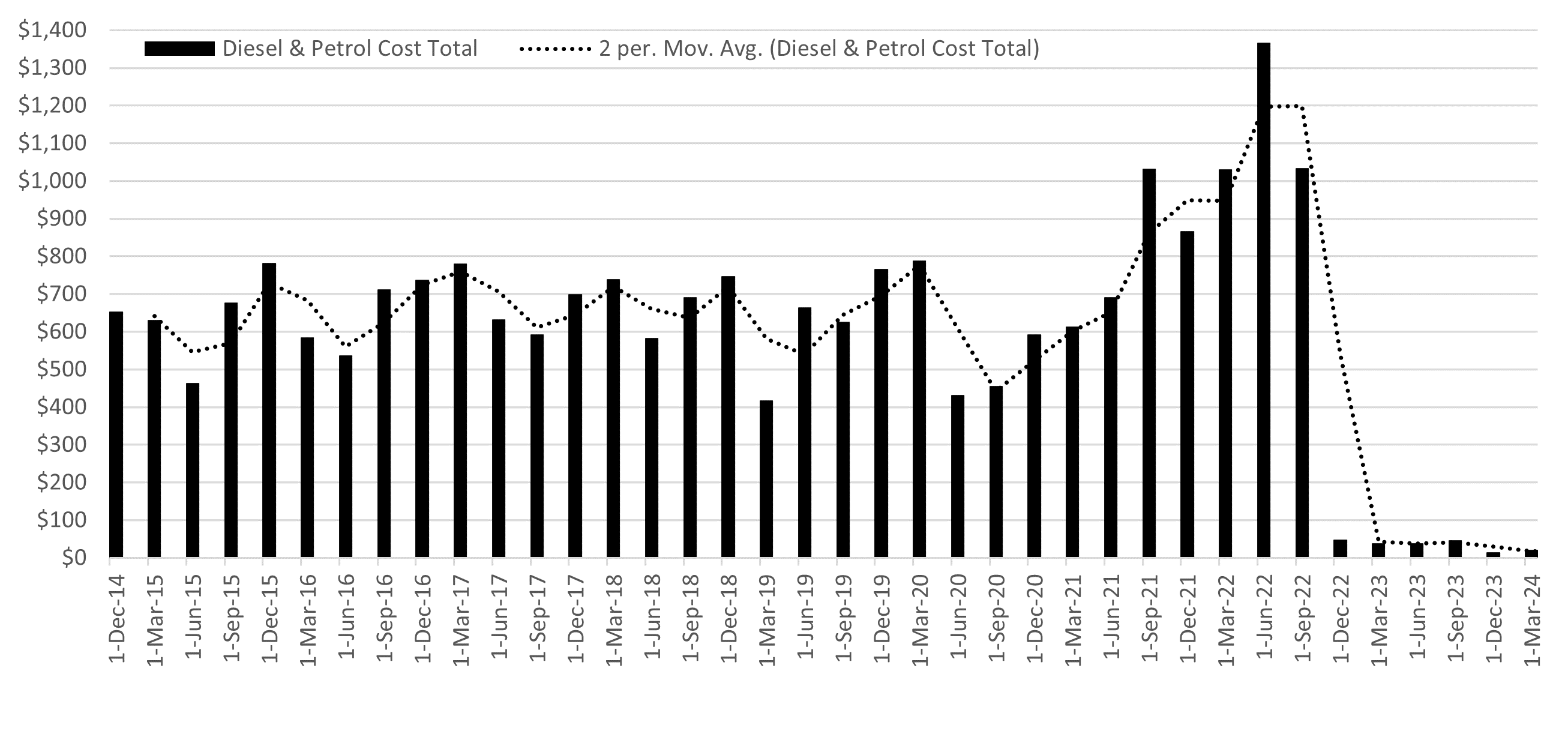
Fuel Costs (2015-now)
- Last updated: 1 January 2026 (zoom full image)
- In 2012 we got an ex-showroom 2011 diesel Captiva SX. We remained a 1-car couple and family for 21 years from mid-2001 until the EV arrived late September 2022. We spent $650 a quarter ($2,600 p.a.) on diesel which rose in 2021 as our oldest son began driving and sharing the Captiva. In 2022 our second son started driving it too. The EV (BYD Atto-3) arrived late September. Nowadays we only pay for fossil fuel to use the 50 cc petrol mopeds, which helped our family remain one-car for so long.
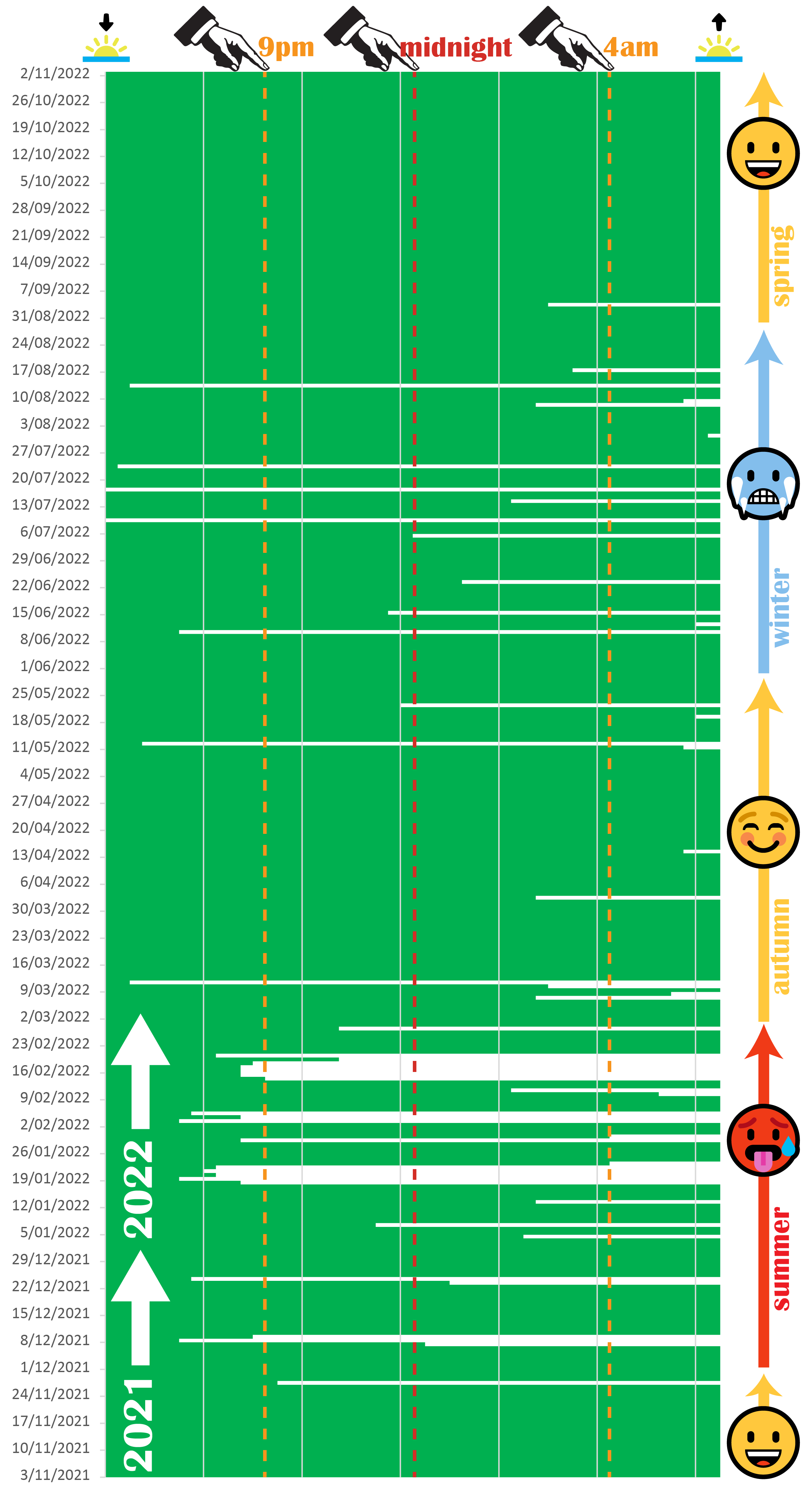
Does the battery get you through the night?
- Last updated: 10 November 2022 (zoom full image)
- For the year after adding a 10 kWh Huawei Luna battery in November 2021 we became 93% self-sufficient for energy. This means each year only 7% of the energy we used came from the grid. The hot nights running air conditioning in peak summer are the killer with self-sufficiency going as low as 85%. In 'deep' winter in Perth July 2022 we were still 93% self-sufficient. The rest of the year it was between 95% and 98% self-sufficiency. It's almost impossible to have a day that's 100% self-sufficient as any spike of use above 5 kW has to be covered by the grid.
- The battery does two main things. On a day with patchy sunshine it grabs energy when it's available and feeds it back while clouds sit overhead and you use energy in amounts that exceed generation. The bigger role is supplying energy from evening to the next morning. It is especially good at avoid evening peak tariffs (can be 50c/kWh). I have done a lot of pre- and post-battery comparisons on Twitter, e.g. 28 December 2022, 10 December 2022, 26 October 2022, 6 September 2022, 31 July 2022, 13 February 2022, 13 February 2022, 3 December 2021, and 14 November 2021.
- A typical day the phases of battery activity are (i) the battery is used to power the baseload overnight that's about 0.3 kW, (ii) as the solar kicks in it charges the battery and depending on the day (iii) the battery is 100% charged and thereafter (iv) output of the battery matches uses [hot water, dishwasher, washing machine] during the day while surplus gets exported then (v) as sun goes down there are spikes of usage, cooking especially, and (vi) then the battery covers the baseload overnight, usually to the next morning. It's rare, but on very overcast days the battery might not get to 100%, but sunny days it's usually 100% charged by 10am. Most mornings the battery has about 30-40% charge left, but the longer nights in winter make it often closer to 15-20% and sometimes to its minimum 2% next day.
- After 1 full year with the battery I analysed how often the battery covers the load all night and to the next day. You can see the graphic on this page (also Tweeted). It shows of 365 days, 341 days (93.4%) it made it past 9pm, 334 days (91.5%) it made it past midnight, 320 days (87.7%) it got past 4am and 310 days (84.9%) it made at all the way through all night to the next day with no grid draw at all. The times it doesn't last long are mainly during summer heatwaves running the air con or occasional rainy, overcast days in winter. The time 9pm is significant as 3-9pm is considered peak time and depending on your plan, you can get stung ~50c/kWh that period.
- The battery is amazing and dramatically reduces reliance on the grid. It cost us about $8,500 and saves about $1,100 p.a. so if you look at it there and then as a financial-only decision the payback is about 8 years. It is warrantied for 10 years and I expect it will last much longer. Also, this payback time is assuming electricity prices won't rise, but of course they will.
What's the heat pump all about?
Last updated 1 January 2026
The heat pump is brilliant. It works like an inside-out fridge, with cool air being dissipated and the heat being released into coils heating the water. Before the heat pump we had a Dux gas boiler of similar volume. It was getting old. We replaced it in November 2020 with an iStore 270L when we installed the first solar panels.
It has various modes, but we have ours set to come on at 11am and not to cycle after 5pm, which means it's usually using solar energy to heat the water. We've not run out of hot water yet despite having three teenage boys. By using solar energy and then storing the energy in the water as heat, in ways it's acting like a battery. It only draws about 1.2 to 1.6 kW while it's running. It runs usually for about 90 minutes each day and works better the warmer the air around it is. It took a little while to work out that it was draining the battery with a disinfect cycle at midnight once a week, so with help from iStore we changed the weekly disinfect cycle to run during the day using solar energy instead. If I had one regret, it would be that we did not move its installation site a little further along the wall away from the window. It has a fan in it so makes some noise like the outdoor unit of an air conditioner.
As you see in the charts above, getting rid of the Dux gas system meant gas use dropped 95%. The bill didn't drop 95% (more like 80%) because of the supply charge, which continued until we shut off the gas in July 2022 and started cooking on electric induction.
The iStore reached 5 years of age in November 2025 and so we got a 5-year service done, which cost $350 and included a new sacrificial anode, which was definitely due. Having had it over 5 years now we still think the iStore is brilliant.
*Not* cooking with gas (anymore)
Last updated 27 March 2023
So what's cooking on induction like? In brief, it's great. I've heard some people who tried under-powered induction cooktop systems and are under-whelmed. Ours is fine. Late 2022, we gutted and renovated our 1980s green laminate kitchen. For $1,600 we replaced the gas cooktop and electric oven with an Omega 60cm Electric Cooking Pack. For us the trick has been to put the cooktop to full power to get it going in 20 seconds then drop it back to the right level. It's very responsive and MUCH easier to clean than the gas hobs.
For us it was mostly about decarbonising and getting off gas, but apparently a lot of gas cooktops leak (methane is 80 times worse than carbon dioxide as a greenhouse gas) plus it can upset asthmatics - also burning a fossil fuel indoors comes with some risks that electricity avoids altogether.
It's easy to work out if your pots and pans are compatible with an induction cooktop ... put a magnet under it and if the magnet sticks, it's compatible. Of all our pots and pans less than 10% were incompatible. Cooking electric was the step that let us completely disconnect the gas.
How's the EV going?
Last updated 1 January 2026
The EV ticked over 51,000 km recently so we're doing about 17,000 km each year. TL;DR it's a nice car, easy to drive and so far, still almost completely powered by surplus solar, i.e. it's being run on sunshine ... i.e. for close to free, potentially saving us $4,000+ p.a. in what we used to spend on diesel.
We got our EV (Atto-3 by BYD) on 29 September 2022. We were wanting the standard, but to expedite delivery we were advised to upgrade to the preferred extended range. It has a range of 480 km on a fully charged battery. After on-road, taxes, rego and then the WA government $3,500 EV rebate it ended up costing about $49,000.
Before we started sharing it with son3, we were driving about 250 km a week. Now it's more like 320 km a week. I commute by bike, but my wife leaves for work before the solar kicks in and gets home after sunset so to begin we would charge the EV on weekends. If it's a good day, sometimes during the week I'd drop my wife at work, leave the EV at home charging and she'll catch the bus home. We have a charger (Smappee EV Wall) that has a smart mode which uses only surplus to charge the car. Our record daily charge is 40 kWh of surplus solar, but with less effort we can put about 20-30 kWh solar surplus in a full sunny day, so that means we can fill the car battery by 30-45%. Was getting a smart charger worth it though? See this mistakes when buying EV chargers article. We made mistake #8. Mistake #2 about not needing the smarts might be true too.
Most of the time we top it up, rarely from much below 60%. The user guide recommends running the battery below 10% once every 3-6 months so we do that when chance provides a time it's running low and there's a good window of opportunity to charge it up afterwards over two or three days using surplus solar.
Since September 2022 we have almost always used surplus solar to charge, but in winters there are periods where we might drive more than usual and it is persistently overcast so we use grid electricity. During the insanely hot 2024 February once we had to charge it after a long trip and it was so hot there was not much surplus solar so used grid. In winter at times I set the charger to its maximum 7kW during a sunny period to quickly charge the car when I know sun will be fleeting. I'd guess overall >90% of the car charging has been solar surplus, with some grid needed during winter months when its overcast and shorter days. Still, much, much, much cheaper than paying for diesel.
Our average annual fuel bill from 2014-2020 was ~$3,000 a year. With our two oldest sons driving, combined with the nationwide rise in fuel prices during 2022, our costs jumped to $4,000 p.a. A tank of diesel for our Captiva in 2022 would cost us about $110 and get us about 400 km. With the Atto-3, a 60 kWh full charge gets us 480 km, and charged on surplus solar 'costs' literally 2 or 3 dollars. That’s all we get if we feed 60 kWh into the grid.
In addition to eliminating gas and crushing the electricity bill, by being able to replace diesel with sunshine, the 'pay back' period for our entire solar energy setup (about $20,000) plummets to ~3-4 years.
Mid-2024: Son1 goes electric!
Last updated 1 January 2026
In late May 2024 the diesel Captiva, driven then only by son number 1, threw an engine light and the repair was going to be over $2,000. As the Captiva was 13 years old with 233,000 km on the clock and balding tyres we decided to send it to the wreckers (no one would buy it). Son1, to my joy, decided to get a second hand EV from the Good Car Company. When most of his friends liked the look of Hilux utes and bigger, having driven our Atto-3 a lot he decided to go electric.
Son1's EV is a 2018 Nissan Leaf ZE1 with 43,000 km on the clock. It was $18,220 and about $2,000 to transport it to Perth. Its range is 250 km, which entirely suits his around-Perth needs, and for any longer trip he plans we'll just swap with him. He picked it up October 2024 and he loves not paying for fuel. It's even made it possibly to use surplus solar better; he and my wife drive to the train/work together and which EV stays home can vary depending whichever needs charging. As a result of this flexibility, we're using more of our solar surplus to charge the EVs.
The Big Switch & $$$$$ Saved
So, here's a composite of all energy costs year-by-year from 2015. From 2023 I added costs for public superchargers (yellow, you can barely see it), which I've only used twice so far on holidays south. Just before we began to decarbonise our household in late 2020, our total energy bills were heading over $5,500 a year and you can see the stark benefits from making 'The Big Switch'. You can see in 2023, which is the first year the house was fully electrified how we paid no gas, barely any fossil fuels ($137) and not much for electricity ($447) - it was only $612 for all our 2023 energy costs ($51/mo. or $12/wk), including charging an EV, running an air conditioner in summer, all water heating and all cooking by electricity. The 2024 column was $820 consisting of $747 for electricty, $36 for moped petrol and $37 on superchargers, but 2024 included Perth's hottest February on record and son1 sharing our EV for almost 4 months during winter. In 2025 the cost was $695 consisting of $634 electricity, $34 moped petrol and $26 on superchargers. To see a larger image file, click on zoom full image.
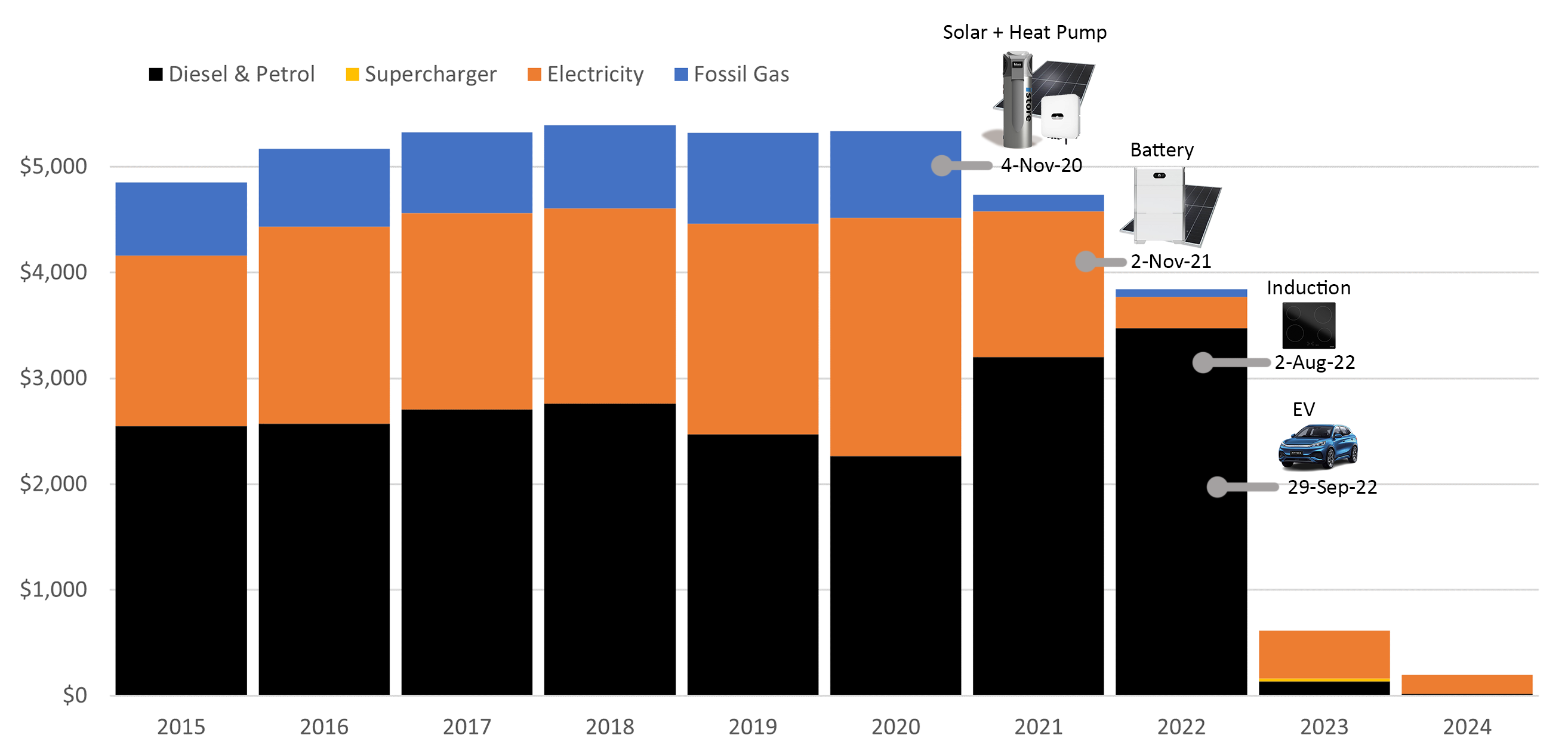
Annual Energy Costs (2015-now)
- Last updated: 1 January 2026 (zoom full image)
- Total energy costs displayed annually. The heat pump (late 2020) got rid of most gas costs. Solar (also late 2020) slashed electricity costs, but the battery (late 2021) slashed electricity bills as low as $292 for 2022. The most obvious impact was the EV (late 2022) that removed the large fuel costs. The column for 2023 is a super drop to just $612 for the whole year. Our first full winter with the EV didn't see electricity costs to blow out a lot (see Tweet 31 Aug 2023). The winter electricity bills in 2023-2025 ticked up a bit due to EV charging, but it's trivial compare to what we used to pay for diesel. The year 2025 was a full year of charging not one, but two EVs and our energy costs didn't change.

Return on Investment (2020-now)
- Last updated: 1 January 2026 (zoom full image)
- Many people want to talk about return on investment, so to calculate what we would be spending I extrapolated what the trends for gas and electricity were from 2015-2020 and for fuel I extrapolated costs based on 2015-2022 and then let them rise 3% per annum. The lines show these estimates and assumptions seem fair. Had we not done anything different, by 2025 we'd have been paying $6,500 more in energy costs - mostly fossil fuel ($3,800), but also $1,000 a year for fossil gas and about $1,900 more for electricity that would all have to be from the grid.
- So what was our payback time? Well it depends what you include in the 'investment'. If we include the solar panels, inverter, heat pump, solar battery, EV charger, and electric cooking pack it's $22,500. Based on the above extrapolations and assumptions our investment was paid back by the end of 2024. Some might say the EV is an investment, but cars are not investments because investments save you money or increase in value. Cars are a very costly consumable and our Captiva had reached the end of its life. I included the heat pump in the investment, but it was replacing an aged gas unit.
- With the investment paid back by the end of 2024, this means after 2025 we're $6,500 ahead and after 2026 we'll be another ~$6,500 ahead ($13,000) and we'll keep benefiting more and more for the life of the system, which could be another 10 years. We're also charging a second EV and off-setting another $3,000 or so in fuel bills son1 would otherwise be paying for. All in all, we're very, very happy that we electrified!
So what would we do if we could start over?
Last updated 1 January 2026
Easy ... get the biggest damn system we possibly could! If I knew we'd be saving over $6,000 a year and everything would become electric so fast (esp. the car) I'd have gotten bigger everything. We have a single phase house so we're limited to a 5 kW inverter, but apparently conversion from single to 3-phase costs between $570 and $800 through Western Power.
With the biggest savings being made from charging the EV (well, two EVs now) with surplus solar I wish we had a more powerful inverter so we could charge at the maximum 7 kW instead of the ~4.5 kW which is the best we can manage and cover baseload without going above 5 kW (and drawing grid). A bigger battery would have meant we could top an EV up daily, which with our 10 kWh battery we don't have much spare energy stored. We're easily charging our 10 kWh battery to 100% and could have gone bigger.
If I had a do-over I would also consider putting extra solar panels vertically on the back wall to catch the late afternoon and evening sun. They would not be visible from the ground, but would give us more energy when we need it most i.e. during the early evening when you cook or when it's too early to turn off the air conditioner on a hot day. Even with quite a few west-facing roof panels, our solar generation drops off quickly from 4.30pm, even in summer. We're a house of early risers too so I might even have put some solar panels east-facing to get the solar generating as soon as the sun rises. Currently it takes until 7.30 am before the sun reaches around to the north-facing roof panels to cover baseload and start battery charging.
That said, the boys have begun to move out of home and will probably all move out within the lifetime of our current system. So we will probably go back to a one-car household and need less energy in general as the years roll on.
